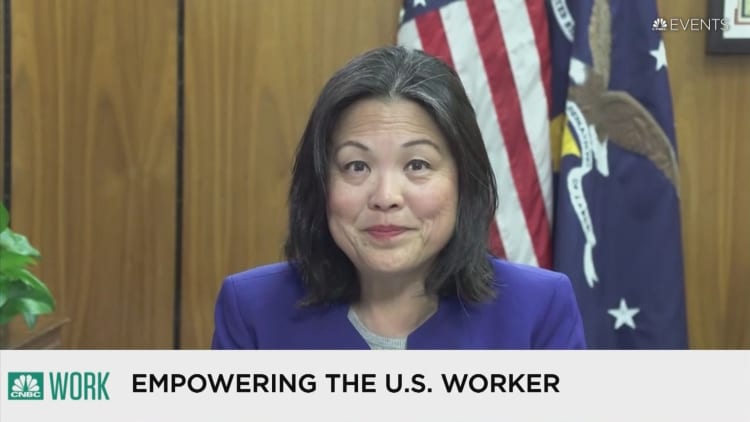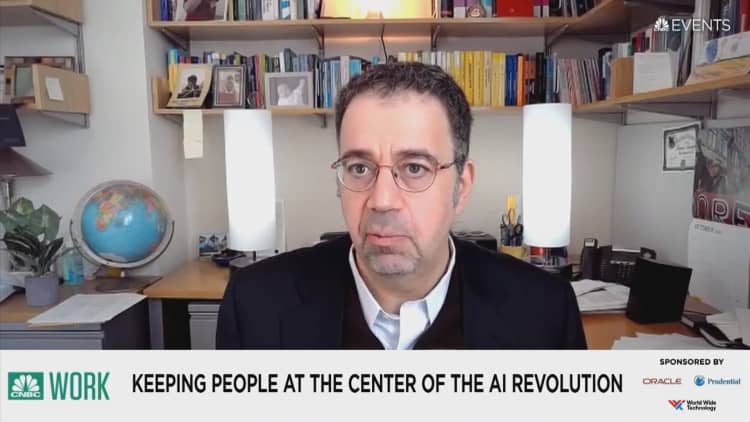“It’s not just ‘the robots are coming’ and we need to hunker down and prepare for it. The choices we make along the way will determine the impacts,” Department of Labor Acting Secretary Julie Su said about AI and workers at the CNBC Work Summit.
Yuichiro Chino | Moment | Getty Images
Recent tough stances from unions in bargaining for better worker deals in industries from autos to Hollywood included AI and automation as a primary demand, and there’s a lesson there for all workers, says Julie Su, President Joe Biden’s Acting Secretary at the Department of Labor — AI displacing workers is not inevitable.
“It’s not inevitable when workers have a seat at the table and can make choices and demands,” Su said in a conversation with CNBC Economics Reporter Steve Liesman at the virtual CNBC Work Summit on Wednesday.
“In the various negotiating tables I have been a part of or watched, from healthcare to Hollywood and hospitality, workers are saying we want choice in how AI is utilized,” Su said.
There is good reason based on history why workers need to not be complacent as AI comes into the workplace. Su cited recent negative impacts on workers as technology has become more central to corporate productivity, from worker health and safety concerns as automation speeds up production lines, to the surveillance technology used for many reasons, including to deter workers from organizing, and AI that can be used to reinforce discrimination and bias in hiring and promotion (she allowed that when designed properly, AI has also been shown to remove bias from hiring processes).
“There is going to be an impact on the workforce from AI,” Su said. “We want to be thinking proactively about the impact,” she said.
To the extent there is job displacement, Su said the government needs to be thinking about what it will do to help those workers. But in other ways innovation will improve the lives of workers, doing parts of jobs that are difficult to do or “backbreaking and grueling,” she said. “It’s not just ‘the robots are coming’ and we need to hunker down and prepare for it. The choices we make along the way will determine the impacts.”
“The most important point is none of it is inevitable,” she added.
The Labor Secretary said the recent Executive Order from the Biden administration on AI is the most sweepings from any administration and it covers the roles that the government and private sector should collaborate on in developing and deploying AI in ways that are beneficial for workers while also including guardrails.
“One of the most deep misunderstandings,” she said, is that it’s either innovation or workers’ rights.
The EO, she said, is as strong on workers’ rights as it is on data security and national security, though some criticism has stressed it is only a first step. “We can and must not adopt a framework that it’s either innovation or worker wellbeing,” Su said. “What we are intent on amplifying in this process is that innovation and workers rights should go hand in hand,” she added.

While Su’s central theme may be logically consistent, the choices made to date don’t inspire confidence in workers’ collective future, said Daron Acemoglu, MIT Institute professor of economics and the co-author of “Why Nations Fail and Progress and Prosperity.”
Acemoglu, who studies economics, labor and inequality, has been warning lawmakers for years about the potential worst-case scenario for AI and jobs. He said there remain two paths, including a best-case scenario, but so far, he does not see our labor market headed in that direction.
Part of the issue for workers, he said at the Work Summit, is that there is “such a huge gap” between the best-case and worst-case scenarios when it comes to AI.
The best case, Acemoglu said, is that “AI will develop as pro-worker, meaning it will keep humans at the center: it will try to make humans more capable, more knowledgeable, better problem solvers, better able to deal with complex tasks, and as such, will help workers earn a better living, create more good jobs and perhaps even reduce inequality.”
The worst case scenario for workers
However, “the worst-case scenario is very scary,” he said. “It would damage the economy by laying off a lot of workers because it will go down a very rapid automation path, it will boost inequality between capital and labor and different types of labor, and it can also damage democracy and many other aspects of the social fabric of our lives.”
He is not the only one warning about the potentially new and powerul inequality issue.
One problem with achieving a better outcome for workers is the thrust of most AI research since its founding days in the mid-20th century.
“The AI field has been shaped by the pathbreaking ideas of Alan Turing and his followers, which put autonomous machine intelligence at the center of what we are trying to achieve and trying to create more and more human-like machines is very much motivated by this agenda,” Acemoglu said.
The approach Acemoglu prefers is “machine usefulness,” which would be “trying to make the machines better for humans.”
“We really need to start building a consensus around the idea that it is feasible and socially desirable to have pro-worker, pro-human AI,” he said. “And then we need to start thinking about what the institutional structure is to best guarantee that.”
Acemoglu has cited the recent executive turmoil at OpenAI as an example of the ongoing tensions and the side winning so far moving full speed ahead with an approach that isn’t necessarily going to lead to the best outcomes for labor, with the incentives being pursued aligned with dominating the market and become the largest player in AI.
Delegating decision-making “to a few very powerful people in Silicon Valley,” is not a good sign, he said. “Given such tremendously different outcomes, it’s a big item of faith to say the market will sort it out by itself,” Acemoglu said.
Business leaders can think of labor as a cost to be cut, or they can think of labor as their most important resource, which needs its capabilities boosted. “Every leader does a bit of both,” he said.
Ultimately, he is convinced that the greater competitive edge will be gained by organizations that help workers perform more complex tasks, and increase the quality of products and services.
“Where we can make blue-collar workers, electricians, nurses, teachers much more capable because we give them tools to be better workers and create much higher quality services, I think that’s the aspiration,’ Acemoglu said.
But right now he sees the world “rushing down the easiest road, the lowest resistance path,” which is automation as a business model and more collection of data.
“It’s going to take some sort of step back to think about where we want to go and how we can actually achieve that; we’re not doing that right now,” Acemoglu said.

 EU News Digest Latest News & Updates
EU News Digest Latest News & Updates



